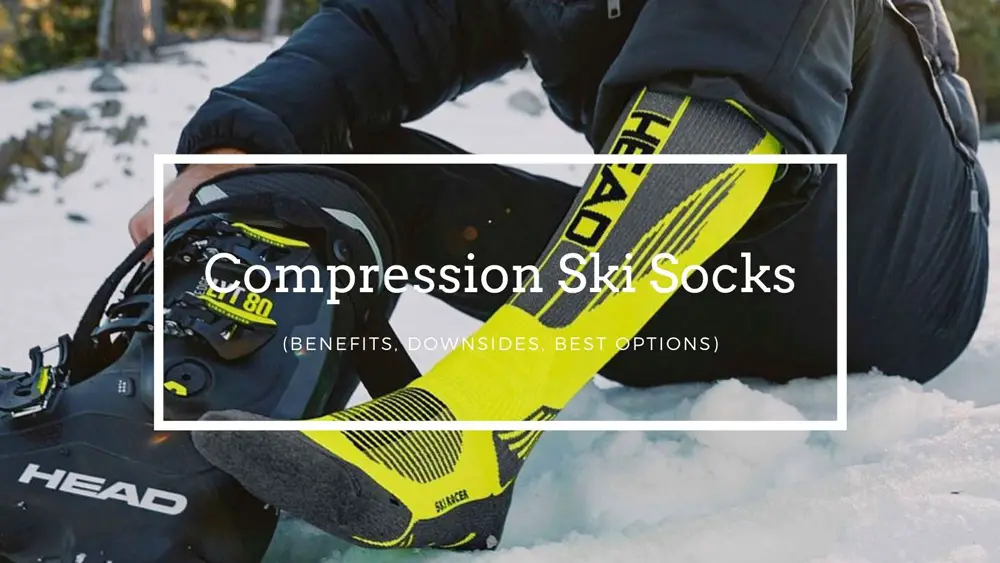As exciting as the idea of skiing on a chilly winter morning sounds, it can be challenging if you aren’t armed with proper skiing gear.
And a crucial part of the outfit is your compression skiing socks, as they can influence the efficiency of your skiing performance to a great extent. Specially designed to facilitate ideal comfort and foot movement during skiing, a pair of these socks is what you’ll need to buy at the earliest.
But given the availability of so many options, which one should you go for? Don’t worry; we’re here to help you out with our comprehensive guide. So, read on.
Compression Ski Socks : Our Top Picks
To ensure that you get the best compression ski socks here’s a quick summary of my top picks.
Best Overall: Smartwool PhD Pro Mountaineer
“My husband loves these compression socks. Says they are the most comfortable ones he’s had so far”
Best Value: Pure Athlete Merino Wool Compression Ski Socks
“I am a senior skier and have been using compression socks for a long time. These are the most comfortable ski socks I have worn in over 50 years of skiing.”
Best Budget: Physix Gear Sport Compression Socks
“Best and most comfortable compression socks at any price point”
Best Ultralight: CEP Ski Ultralight Tall Compression Socks
“I am a Ski Instructor with Vail Resorts. I highly recommend cep compression socks! Great fit, comfort, quality, and workmanship.”
Best Overall: Smartwool PhD Pro Mountaineer
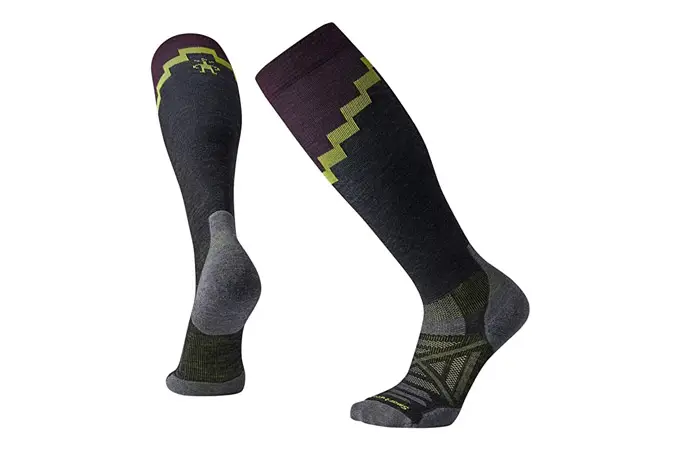
Materials: 49% Merino Wool, 43% Nylon, 8% Elastane
Designed to deliver the highest degree of skiing performance, these Smartwool PhD Pro Mountaineer Socks are the best model for the 2021-2022 season. Formerly the PhD line, designed in partnership with Conrad Anke, coupled with patented Virtually Seamless™ and Indestructawool™ technology in the high-impact areas, lends ultimate durability to these socks.
We also appreciate its 20-30 mmHg graduated compression rating for speed recovery and fatigue reduction. Plus, the non-cushioned leg and sole ensure a close fit in any tight-fitting performance ski boots.
And that’s not all; the socks come with extra friction protection and a 4 Degree™ Elite Fit System for a dialed fit with flex zone at the ankle joint.
What we like:
- Facilitates highest degree skiing performance
- Offers ultimate durability
- Provides a close fit in any ski boots
- Enables speed recovery and fatigue reduction
What we don’t like:
- Tightness at the top of calf
Best Value: Pure Athlete Merino Wool Compression Ski Socks
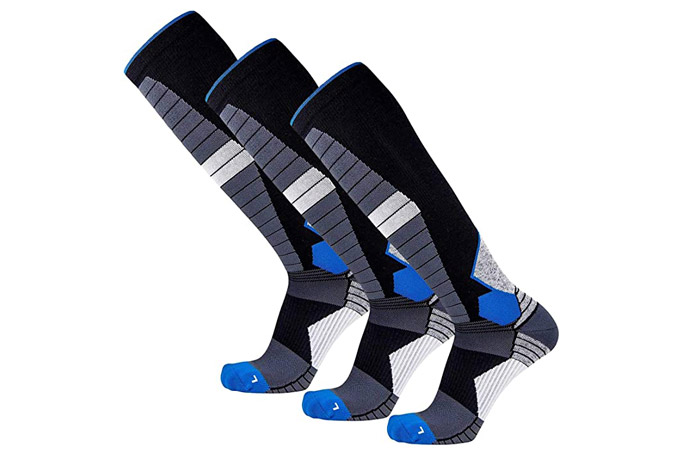
Materials: 50% Nylon, 32% Merino Wool, 13% Lycra Spandex, 5% Acrylic
Next up is another dependable pair from Pure Compression, which can energize the legs adequately to ensure a comfortable and efficient skiing performance.
Firstly, these socks offer a second-skin fit, so they feel neither too tight nor too loose on your skin. That’s why they stay in place all day while you’re snowboarding or skiing. Even the compression offered is on point to enhance blood circulation, and the legs are energized while skiing.
Speaking of the material used, the socks consist of a blend of merino wool and hence, offer the right warmth without being very thick. This also ensures they fit comfortably into your ski boots.
What we like:
- Improve circulation
- Adequately warm but not too thick
- Stay in place while skiing
- Fit comfortably into any ski boots
What we don’t like:
- Large-sized variants are costly
- A little snug around the toes.
Best Budget: Physix Gear Sport Compression Socks
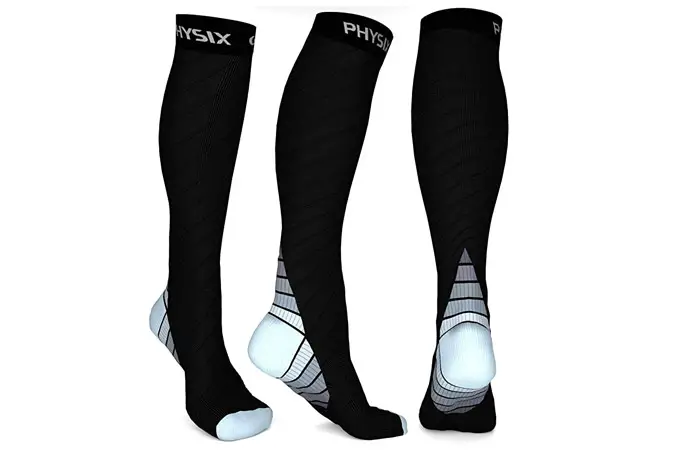
Materials: 70% Nylon, 30% Spandex
Want a pair of compression ski socks that can outlast other average varieties on the market without compromising on comfort or quality? Then this one will be a great budget choice to go for.
Made using 30% spandex and 70% nylon, it comes quality stitched to ensure absolute comfort while skiing. It also facilitates ideal support and compression on the foot calves and the heel so that the toe area doesn’t squeeze the toe joint. As such, you can pull off an efficient skiing performance effortlessly.
Other advantageous features include effective moisture wicking property, washable design, and fatigue-reducing ability.
What we like:
- More durable than merino
- High-quality and secure stitching
- Provides ideal support and compression
- Facilitates efficient skiing performance
- Easily washable
What we don’t like:
- Not the softest on the market
Best Ultralight: CEP Ski Ultralight Tall Compression Socks
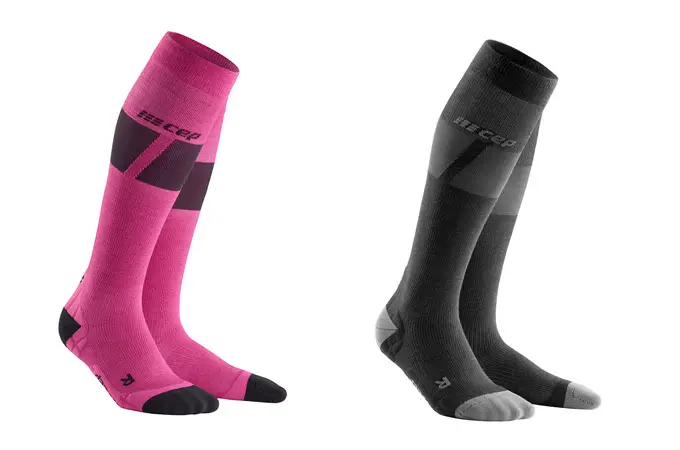
Materials: 66% Polyamid, 17% Merino, 17% Spandex
Ultralight ski socks can be a great option for skier who has a good fitting pair of boots and wants to take their skiing game up a notch. The CEP Ultralight Ski Sock is a winner of the thinnest ski socks.
With a new 200 needle construction with ultra-light materials, these thinnest socks make them itch-free with direct contact to your boot. Made with a quality mix of merino wool and superior moisture wicking fiber, the CEP Ultralight Ski Sock is a great choice for those suffering from cold feet and want to boost circulation for stronger legs and warmer toes on the slopes.
Optimized for applying the perfect amount of compression in the calf and feet, a CEP’s proprietary construction, the Compression Sock 3.0, delivers true graduated compression that increases greater oxygenation in the blood and provides an improved energy supply of the muscles.
Pros
- Performance-focused designs
- 20-30mmHg graduated compression
- Anatomically optimized foot section
- Offers sufficient warmth
Cons
- High price tag
Dissent Ski GFX Compression
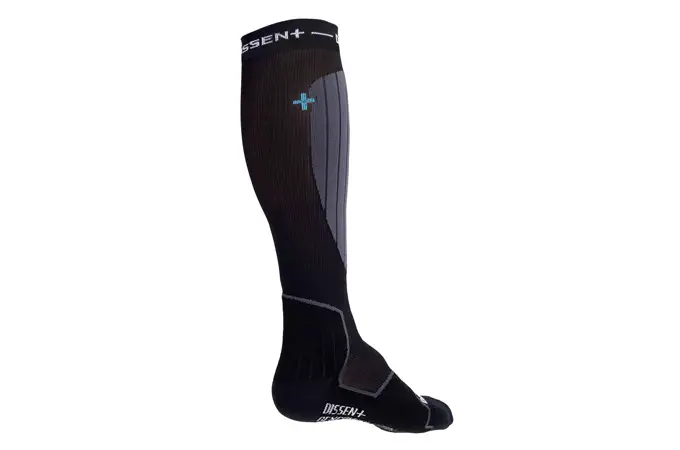
Materials: Synthetic blend
Lastly, we’ve picked these DLX-wool socks from Dissent that perform considerably well in offering a smooth and comfortable skiing performance.
What we liked the most about these socks was the compression on offer, as it provides perfect arch and ankle support, reducing foot numbness considerably. In addition, the use of a specialized NanoGlide anti-friction yarn on the toes, heel, ankle, instep, and forefoot prevents hotspots, skin chafing, and blisters.
Another noteworthy feature is the profiled 3D-mesh part over the forefoot region, which provides improved breathability. This also ensures adequate protection from stitching, laces, and hardware such as buckles.
What we like:
- Reduces foot numbness
- Prevents skin reactions
- Provides improved breathability
- Protects forefoot from shoelaces and hardware
What we don’t like:
- More expensive than other options
Are Compression Socks Good For Skiing?
The benefits of these compression socks are backed by science. Professionals who make compression part of their exercise routine know that it can improve blood flow, reduce muscle pain, and recover faster from exercise. All skiers should also be taking advantage!
The compression ski sock has come a long way in recent years. Sock scientists at major sock brands are busy beavering away at new technology to produce more and more compression options for your next skiing adventure!
High-performance compression ski socks are proven scientifically and practically to:
Improve Blood Flow
First, the goal of wearing compression ski socks is to improve blood flow in critical areas of the foot. When you wear compression ski socks during intense athletic activity, the walls of your arteries dilate, which allows the blood vessels to become more open, resulting in an increased amount of blood flowing to your muscles. The more oxygen-rich blood that your heart can supply to your muscles, the better your muscles can work harder.
Support calf muscles and Increase stamina
A good pair of snowboard compression socks do more than aid circulation. When you exercise vigorously or for a long period, you may experience muscle vibrations because of muscle fatigue. Compression socks support your calf muscles for optimal alignment and reduce muscle vibration. Less muscle fatigue can mean that you will have longer stamina to extend your ski session and are less likely to injure yourself in the future.
Warmth, Short Recovery Time & Prevent Future Injury
In a ski sock application, the improved blood flow boost from graduated leg compression generates more benefits in your body. It provides extra warmth to the muscles while skiing, helping your body regulate its temperature while active on the slopes. This is a great advantage for beginner skiers who need extra padding and warmth because they’re generally less nimble.
Not only will compression ski socks offer an increase in warmth, but increase body waste disposal. A compression sock will help you flush out the lactic acid and other waste products in your muscles, allowing for a faster recovery time.
Nothing is worse than injury from the skiing day. Compression skiing socks are a great way to prevent swelling and injury. Since they compress, they also reduce any swelling caused by accidents. This compression also reduces the pressure on your joints and supports your calves for a more fluid skiing experience.
Fitting & Comfort
Compression skiing socks fit exactly as you’d expect: they are well tight. I love wearing them because there’s no more worrying about slipping down or having a bunch of extra fabric between my skis. This is a huge advantage for those who spend the day on their feet in skis or boots – no more uncomfortable slipping.
The only downside might be getting used to putting these on, but once you get used to them, they’ll fit perfectly.
Downsides of Compression Ski Socks
Compressed ski socks have been designed with the needs of skiers in mind, and the benefits may seem obvious. However, there are a few downsides before buying compression ski socks:
Pricy
One downside is that they are expensive. They can cost nearly double what you would spend on comparable standard ski socks, especially these Merino wool ski socks. If you are looking for comfort and secure fit and want to be warm all day, faster muscle recovery, then go for spending the $30 to $60 for a pair of merino compression snowboarding socks.
Itchiness and Dry Skin
A common problem with compression socks is that they can be itchy and cause dry skin. If you have extra sensitive skin or skin diseases, try a different brand or switch to regular cotton socks for a day or two. This should give your skin a chance to heal and stop being so irritated.
Final Thoughts
So, that was all about compression ski socks and the best products on the market today. We hope that, by now, you’ve developed a clear idea about these indispensable skiing accessories. So, choose an ideal option, and witness the difference in your skiing performance!
But before we call it a day, here’s the last tip for you. To maintain your socks in the best manner, you should follow the instructions laid down by the manufacturer accurately.
And that’s all for today. Watch out for this space, as we’ll soon be back with more such interesting guides. Till then, take care!

